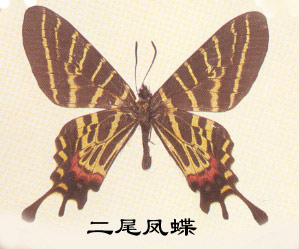Alias of the two-tailed swallowtail butterfly: the two-tailed brown swallowtail butterfly, the two-tailed brown swallowtail butterfly, the Yunnan brown swallowtail butterfly, and the two-tailed brown silk butterfly.
Wingspan is 65~77mm. The wings are dark brown, with 6 yellow or yellow-white oblique transverse bands on the upper half of the forewing, from the 1st and 2nd bands from the base to the trailing edge, the 4th and 5th bands merge in the middle to the rear edge, and there is 1 in the sub-peripheral area. The strips run from the leading edge to the trailing edge, making the ratio of yellow-white to black background almost equal on the wing surface. The yellow markings on the hind wings are relatively scattered. There is one oblique horizontal band in the subunit area, 2 to 3 bands in the upper half of the middle area, one zigzag yellow band and one red band in the lower half reaching the rear edge, and the outer edge. There is a row of yellow markings on the area; the outer edge is blunt-toothed; there are 2 tail processes, the elder end is enlarged and hammer-shaped; there is a thumb-like protrusion on the hip corner. The back of the wing is similar to the front except that the veins and interveinal lines are very clear.

Biology: One generation occurs per year. Adults mostly inhabit alpine canyon woodlands with a mild climate above 2,000 meters above sea level, dry and sunny winters, and relatively humid summers.
Distribution: Sichuan and Yunnan, it is a unique species in China, one of the rare butterflies, and a national second-level protected wild animal. "Threatened World Papilio" is rated R (very few individuals).
[Protection significance and measures] The cause of the endangered species is unknown, but over-collection is undoubtedly a serious threat. This species is a rare species in the world, and there may be new subspecies yet to be discovered scientifically, so it is listed as a protected species. It is recommended that its habitat be established as a nature reserve, and capture and random collection are strictly prohibited; basic research on ecology and biology should be carried out.
animal tags:
We created this article in conjunction with AI technology, then made sure it was fact-checked and edited by a Animals Top editor.